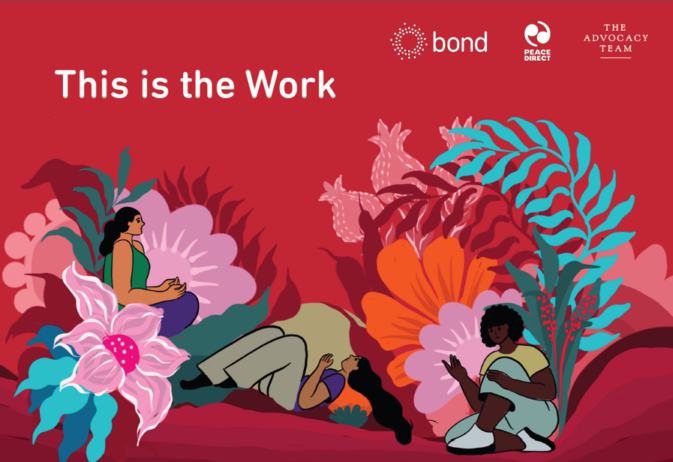It’s how, not how much: rethinking “scale” in transformational change
I am allergic to the concept of “scale.” I stated this in the Q&A part of a talk I was honoured to give at Bond a few weeks ago.
A rather flippant statement, but also one that is apt to the question of what funders seek from their investments and why it isn’t always the right question to ask grantees.
My recent talk at Bond focused on work I’ve done with the support of the Rockefeller Foundation to explore leadership that catalyses transformational change. My team released Transformational Change Leadership | Stories of Building a Just Future (“TCL”) a few months ago, a story-based resource that examines the leadership process and the characteristics that unite leaders who create “impact at scale.”
One of the questions my team and I explored was, “What does it look like to create impact at scale?”
Why are we asking about “impact at scale”?
The term “scale”, while not defined universally in global development, often means a solution that is seen to be successful and transformative in one context which is then replicated across other geographies or cultural contexts to reach millions of people.
Why are people looking for scale in this sense? There appears to be an assumption among actors in the development and social impact sectors that successful solutions will solve systemic problems around the world if we can just figure out how to replicate them and reach millions. One of the first questions asked about a solution or programme with demonstrable impact is often about scaling up. But this question can too often lead to undue pressure on a successful project or to a dilution of its original intended impact.
Subscribe to our newsletter
Our weekly email newsletter, Network News, is an indispensable weekly digest of the latest updates on funding, jobs, resources, news and learning opportunities in the international development sector.
Get Network NewsThe problem here is not scaling per se. It is crucial to apply and transfer knowledge and effective tools across multiple sectors, geographies, and situations. But we need to reframe value judgements on size and reach by assessing the real impact on people’s lives.
TCL theory of scalability
While creating the TCL framework, we deliberately did not define or narrow what “scale” means in the context of transformational change. The TCL theory is that transformational change is not dependent on size or the audience reached, but rather is dependent on change that is appropriate and specific to the cultural, political, social, and economic contexts of the affected community. It also embeds and deepens in its impact over the long-term, and involves systems change.
In other words, “impact at scale” means reaching the right people and meeting them where they are, while trying to deepen engagement and reaching as many as possible within your existing means and goals.
Transformational leadership
We mapped organisations and individual leaders who engage in a process that meets these criteria (and also are examples of the TCL process we’ve set forth) regardless of the population sizes or geographies reached.
On the one hand, organisations, such as the Aga Khan Development Network, WIEGO, and La Via Campesina, have used specific models of change that have catalysed transformation for millions of people over time and across sectors and geographies. Each of these organisations are multi-faceted in their approach and expansive in their community reach without diluting their impact.
On the other hand, we have examples such as Konbit Solèy Leve, The Melissa Network, and Puente Nayero Humanitarian Space, for which scaling to millions of people is not part of the impact model and is not necessarily the goal. It might even be counterproductive and ineffective: any concentration on scaling to millions could potentially rob the leaders of their power and the programmes of their unique community-facing qualities by imposing assessment criteria that shift them from purpose and effectiveness. The common factor in these latter cases is the work of transforming a local community through attention and deep listening to their lived experience and needs. And then providing solutions and services to help them navigate toward their own positive transformation.
In the end, regardless of how many people are reached, the determining factor of success is how deeply change is embedded and how the community is transformed. It’s how, not how much.
Asking the right questions
When I look at building understanding of and applying the TCL framework, one of the first questions I ask is: what support do leaders need to catalyse transformation, and how can TCL be of service? I am gaining clarity on the types of supports required, such as: funding, tools, technology, training, spaces for experimentation and dialogue, stronger networks, and strategic support for narrative, communications, and impact assessments, among other resources.
In terms of scale specifically, the first questions should be:
- Do you need to scale? Why?
- If so, who are you scaling to? How will they benefit?
- How do we ensure the core of your transformational work is not diluted, either where it’s currently happening or where it could potentially scale to?
- How do you continue to deepen the work and not just spread it to other populations?
- If you have answers to all the above, how do we support you to scale?
If we can reframe our notions of what impact at scale means – that it might mean scaling to millions, or it may mean scaling deeply and systemically with one community only – we can reframe our understanding of impact itself and how we invest in and support movements, communities, and organisations.
This post is part of the author’s “Building a Just Future” article on transformational change leadership.
Category
News & viewsThemes
Operations and contracts



